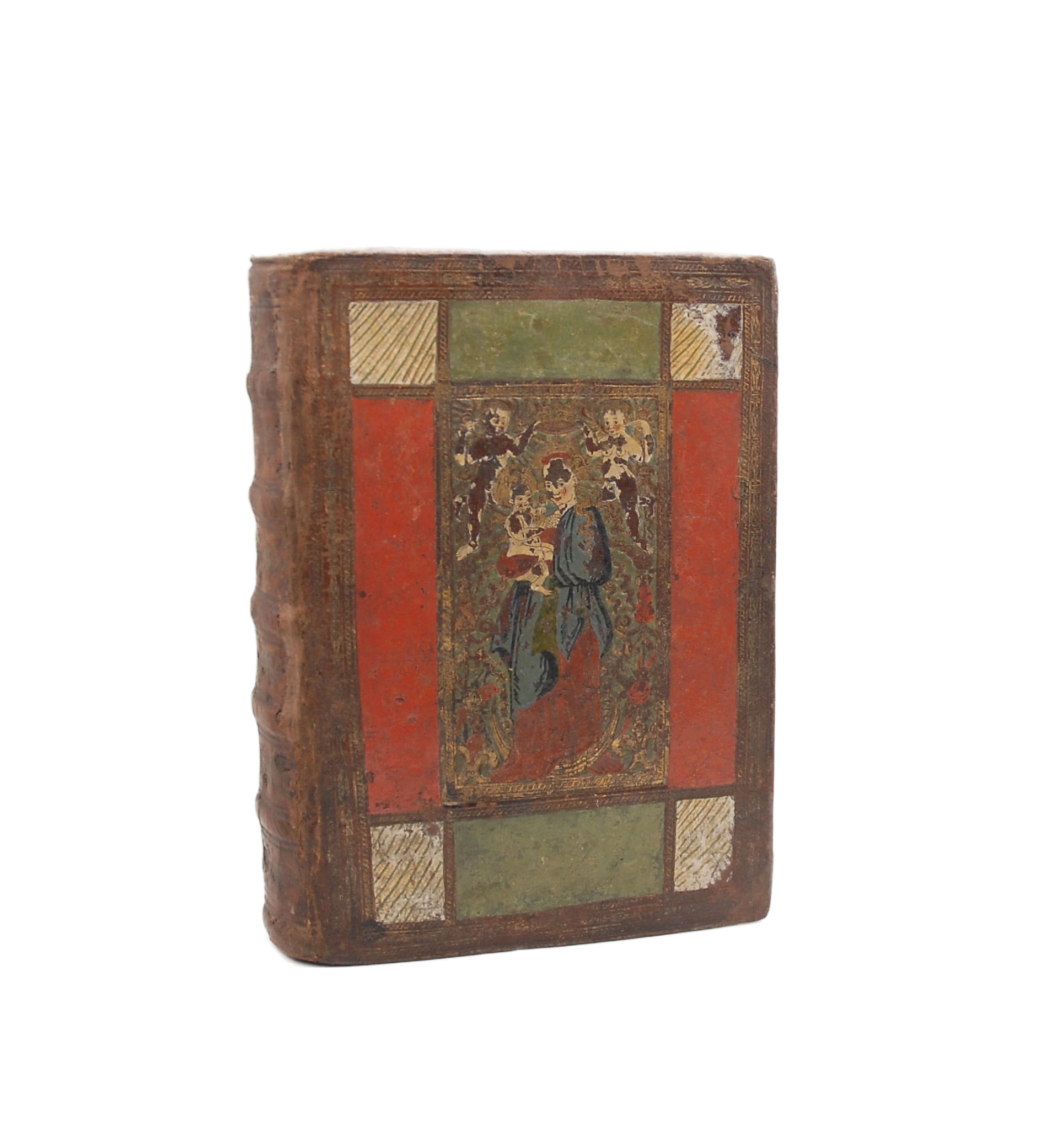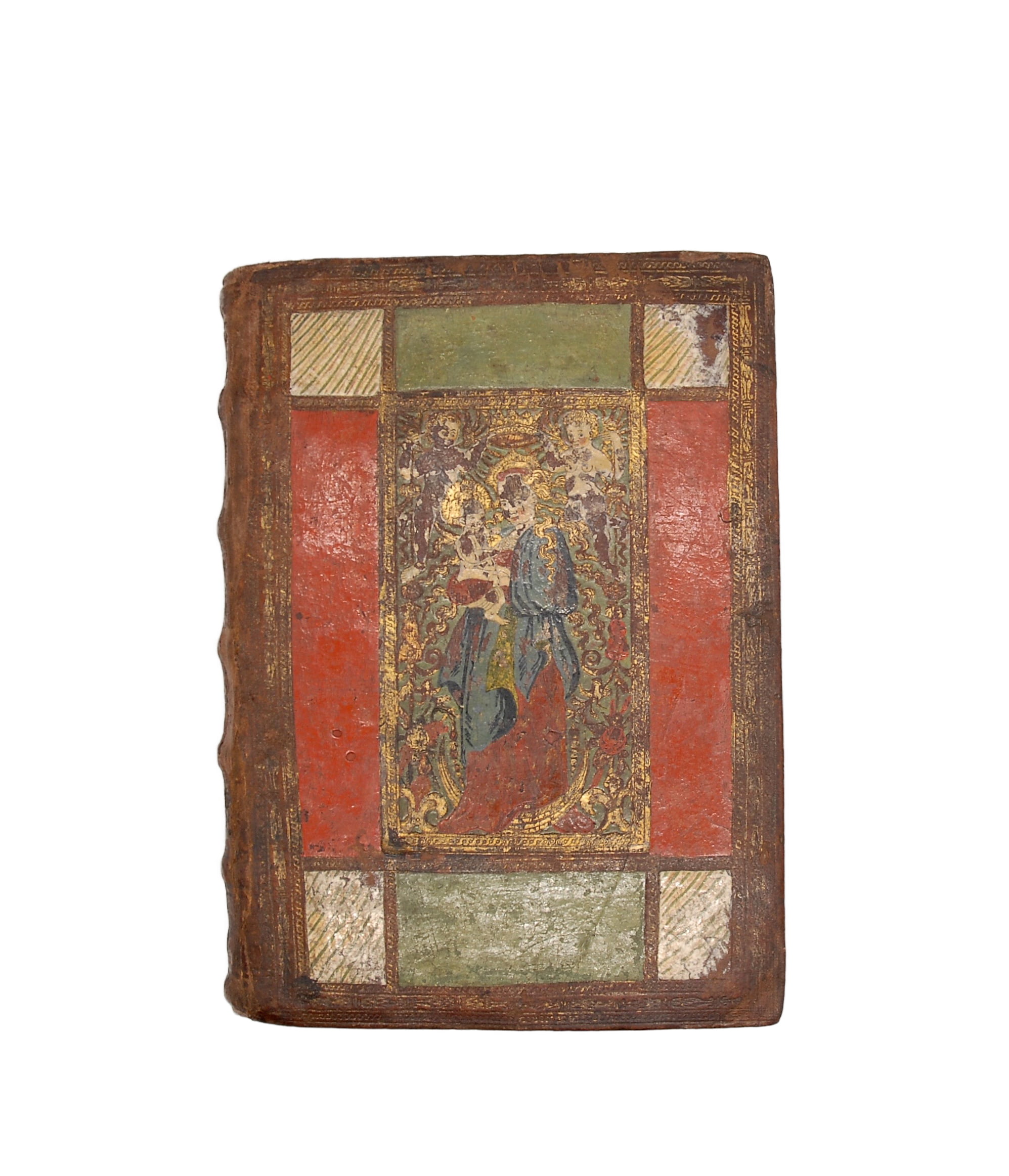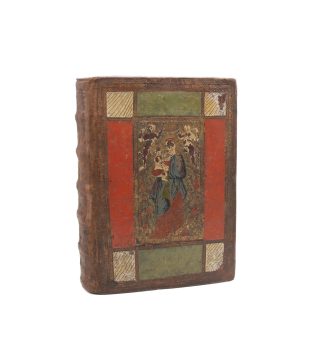ULRICH, HERZOG ZU MECKLENBURG
SUPERB CONTEMPORARY PAINTED BINDING
Kurtze wiederholung etlicher fürnemer Heupstücke Christlicher Lehre.
Leipzig, [Michael Lanzenberger], 1600.£15,000.00
Small 4to. pp. (xxvi) 604 (x). Gothic letter. All pages within richly decorated woodcut border with grotesques, saints, biblical scenes and escutcheons. T-p in red and black also within woodcut border with arms of Saxony, large woodcut arms of Ulrich, Duke of Mecklenburg (with Lucas Cranach, probably the Younger, monogram) to t-p verso, 18 half-page woodcuts mainly of biblical scenes, decorated initials. T-p dusty, usual age browning, upper margins a bit short, the odd damp mark. A very good copy in a superb contemporary calf binding decorated with lacquer paint, double blind ruled to a panel design, within rolls of gilt floral motifs and ropework, centre panels divided into nine compartments with upper cover bordered in red, green and striped white, centre panel with handsome gilt figure of the Virgin and Child surmounted by angels holding ducal crown, painted in blue, red, green and white, lower cover bordered in white, blue, striped red and green, centre panel within gilt ropework, gilt fleurons to corners of outer border and centre panel, gilt centrepiece with interlacing ribbons, all in orange, green, blue, red and white; raised bands, small stars and fleurons in blind to compartments, all edges gilt and gauffered, small unobtrusive repairs to corners, upper joint, and head and foot of spine, a little paint loss from upper cover. Crossed-out oval stamp Herzoglischer S. Meiningischer Bibliothek on t-p, ms. ‘F.[ürstin?] V.[on?] B.[randenburg?] H.[ertzogin?] Z.[u] S.[achsen] C.[leve] J.[ülich] 1682’ in blank margins of verso. In folding box.
The superb contemporary German binding, lavishly decorated with lacquer paint, is very unusual. The upper centre panel, with the Virgin and Child standing on a crescent, surmounted by a (ducal) crown held by angels, is so uncommon that EBDB lists no other instances. The closest contemporary models are the bindings of Paul Droscher (EBDB w004602) (fl.1589-1601), active in Wittenberg, Saxony, near Leipzig, where this edition was printed. Although our binding does not bear his initials, the influence of colour and design is apparent. Droscher’s usually feature a centre (sunken) panel with a standing Luther or Melanchthon, cornerpieces with interlacing ribbons, and ropework borders—all hand-coloured with bright, lacquer-like pigments; one sample (Sotheby’s, 14 Jul 2020) bears on the spine very similar blind-tooled stars and fleurs-de-lys to ours.
The Virgin’s ducal crown suggests this was probably a presentation copy. Since the work was printed in Leipzig, it is plausible that a copy would have been sent to the local Duke (and Elector) of Saxony. In 1600, the Lutheran Sophie of Brandenburg was regent for her son. The unusual Marian centre panel was certainly suitable for a female dedicatee. A good candidate for the initials (‘Fürstin von Brandenburg Herzogin zu Sachsen Cleve Jülich’?) in the 1682 ex-libris is Magdalene Sibylle of Brandenburg-Bayreuth (1612-87), Electrix of Saxony until 1680, though she preserved the title of duchess to her death in 1687. In the C19 the copy was in the library of Georg II, Duke of Saxe-Meiningen; it may have descended through the extended family.
A very good copy of the scarce second, revised edition of this lavishly decorated Catechism by Ulrich III, Duke of Mecklenburg-Güstrow (1527-1603). An educated Lutheran prince and skilled diplomat, he corresponded with scholars like Tycho Brahe and David Chytraeus; through his marriage into the House of Denmark, he was Charles I of England’s great-grandfather. First published in 1594, the work was intended as a private instrument of prayer and meditation. It gathers together, through a collection of scriptural ‘sententiae’, 24 key questions of Christian doctrine, including sin, death, damnation prepared by the devil, Judgment Day, the joy of eternal bliss, justification, the knowledge of divine truth, the invocation of the saints, and New Testament sacraments. In 1561, Ulrich had been among the staunch Protestants who left the Naumburg Diet in protest against revisions of the Lutheran Confessio Augustana, approved instead as a concession to Frederick, Elector of Saxony. This is mentioned in the letter to the reader. The early annotator of this copy was especially interested in Luther’s theological stance, which Ulrich occasionally inserted within comparative discussions on a specific subject. E.g., he included Luther’s view on Christian death, as ‘an entrance into eternal life’, among those of authorities like Cyprian, Bernardus, Augustine and even Euripides!
No copies recorded in the US. Not in BM STC Ger. or Graesse.In stock












